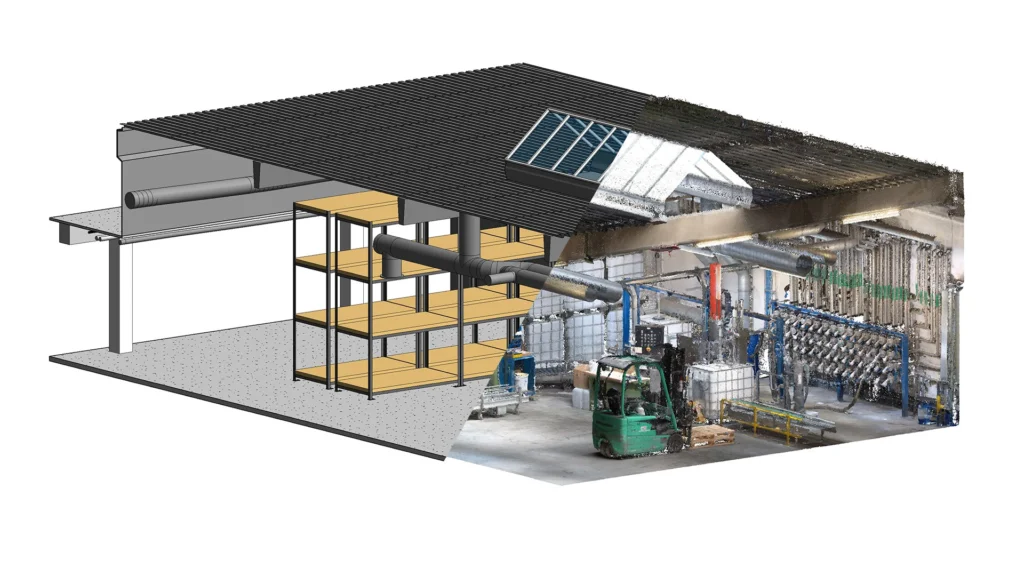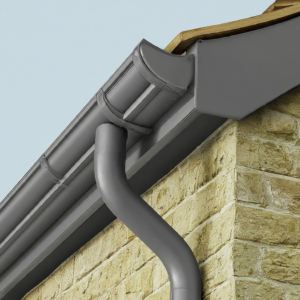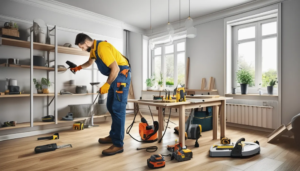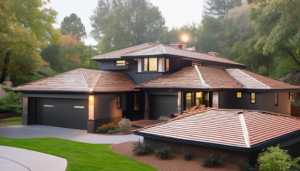
Within the ever-changing field of architecture and construction, innovation plays a crucial role in influencing how building projects are planned, designed, carried out, and maintained throughout time.
Establishing a solid basis for this revolutionary AEC sector transition from Scan to BIM (Building Information Modelling) is noteworthy. It is impossible to overestimate the significance of scanning and 3D modelling at the nexus of conventional building techniques and developing digital solutions.
This method effortlessly combines state-of-the-art Building Information Modelling software with 3D laser scanning technology. The production of precise and comprehensive digital twins, or duplicates of current structures, is made possible by a digitalized transformational process that brings together experts in architecture, engineering, and construction to unleash a future of excellence and efficiency. Throughout the course of the project, decisions are also made using knowledge.
The technology-driven environment eliminates a lot of the typical issues of construction lifecycle management, such as human mistakes, integrated platforms, and cooperation. There will definitely be no more horrifying manual facility and construction site documentation.
The Scan-to-BIM Technology Pathway
A well-planned implementation strategy is necessary to guarantee a seamless and effective integration of Scan to 3D Modelling into the building and design processes. Its fundamental basis is based on highly skilled 3D laser scanners, such as Leica’s. Although 3D scanners were first developed in the 1970s, their current use was not initially intended.
The project’s objective, parameters, and deliverables are initially specified. One of the deliverables is a definition of the requirement for Scan to BIM implementation, whether for facility management, new construction, or rehabilitation. For precise point cloud data, Tejjy 3D Laser scanning specialist recommends using a Leica scanner. Using high-quality 3D scanners makes risk- and cost-controlled settings easier to implement. It is no longer feasible to map, conduct physical surveys, follow development, or check even sensitive locations.
Converted from processed raw point cloud data, useable BIM models are produced. We employ quality control procedures to ensure correctness throughout point cloud data registration by utilising Autodesk’s cutting-edge technologies. Collaboration improves when scanned data is seamlessly integrated into the 3D model within the current workflow. We can locate conflicts and fix them thanks to the integration.
When Should You Use Scan to BIM?
However, when should the scan to BIM workflow be implemented? Now let’s explore the facility management or building life cycle adoption stage, where integrating a scan to 3D model may lead to better returns on investment.
Precise land surveying and mapping
The most commercial art form is architecture. Conditions and occurrences cannot be assumed while designing. That is, however, only true if the land you are designing on is not real.
Challenge: Inefficient site inspections and 2D-perspective drawings are still a regular part of the land registration and mapping procedure in modern times.
The initial step of land mapping and surveying is resolved by capturing reality and converting the gathered data into BIMs (building information models). Thanks to Leica’s RTC 360 and its information tag function, extremely precise land maps that are compatible with geological data are achievable.
Absence of As-built information for Current Structures
As-built drawings show a building project’s actual state. As-built drawings are often created through site visits, hand taping, and reflections of the project’s development.
Challenge: The challenge with traditional as-built data collecting and recording is that it can be expensive and time-consuming for facility management or restoration.
Solution: The laser scan to 3D model approach reduces the amount of time required for human measurements and site inspections by using digital point cloud data collecting. allowing early project completion to reduce construction time and costs.
Using a point cloud, BIM engineers produced an as-built model for the Washington, DC-based “1155 23rd Street Northwest” project.
Better 2D to Scan Visualization
It would be a personal choice to use a 2D documentation method instead of 3D as-built models.In some situations, a person or group of individuals may not be able to provide outputs for documentation that are clear.
Problem: The drawings lack self-explanatory elements and lack level of detailed (LOD). Errors like this might accelerate the project’s advancement.
Solution: Accurate measurement of existing structures is captured through point cloud data collection and registration. To further ensure, convert point cloud data to a 3D model. While it is still possible, clash detecting elements in visualization are not included in scan to 2D. As a result, we gain from reducing rework and saving money.
Simplified Renovation and Retrofitting: The most common uses of scan-to-BIM technology are for whole makeovers and space expansion requirements. To begin with, knowing the space’s existing state is necessary when making judgements about renovations and retrofitting.
Problem: Precise data is lacking in traditional building documents intended for renovation or retrofitting.
Solution: Scan-to-BIM data is digitally recorded and captured, enabling the creation of “digital twins,” or duplicates of the same building. Since there are portable data-capturing scanners accessible, renovating tiny spaces to remote locations with unfavorable physical conditions may be done with ease.
An entirely new level of documentation
On-site measurements, written reporting, and live drawing would be the only methods used in traditional site documentation. It was only a little use case for keeping track of building progress.
Challenge: It may be difficult for traditional methodologies to scale, which makes it difficult to record huge buildings and projects with constrained timeframes or broad scopes.
Solution: Using the most recent laser scanning technology, accurately and precisely capture reality. Then, turn the point cloud data into mesh models and building information models, which may be the initial step towards a variety of task scopes. The digital twinning process may benefit greatly from periodic laser scanning, which would yield precise project and facility conditions.
Planning and Sequencing for Construction
Improved management is the result of planning and sequencing. Digital building management provides more efficient flow.
Challenge: Some time variances are not documented in a standard building setting. Schedules are impacted when some progress track is missed.
Solution: Design variation may be tracked by scanning to BIM. Change management is made simple by the real-time nature of all Revit updates. Simple alignment observation helps all construction stages make well-informed decisions.
Effective facility administration
Managing the interaction of people, location, and purpose is the core of facility management. And keeping meticulous track of all facility assets is the cornerstone of facility management operations.
Problem: Without up-to-date information, managing and maintaining facilities can lead to inefficiencies and higher expenses.
Solution: Laser scan-derived BIM models are useful instruments for facility administration. They support asset management and maintenance planning by offering precise information on the building’s systems, parts, and spatial linkages.
Ensuring adherence to rules
Architecture creates strict guidelines and rules that must be adhered to. particularly now that climate change is a major problem and more people require tougher control.
Challenge: In the absence of precise, as-built data, ensuring adherence to construction norms and regulations can be difficult.
Solution: Since scanning to BIM guarantees accurate documentation, the point cloud registration and subsequent model development technique aids in the creation of models that comply with legal criteria. This lowers the possibility of non-compliance problems by further ensuring that design and construction activities are in line with local building rules.
Analysis of energy efficiency
Insufficient understanding impedes the execution of energy-saving strategies. Furthermore, there might not be enough technical know-how to administer and maintain energy-efficient equipment.
Challenge: Using antiquated methods makes it impossible to create a data-coordinated environment necessary for a well-informed building lifecycle.
Resolution: The process of registering point clouds and then developing models aids in the creation of accurate models. Coordination may be expedited for sustainable decision-making when site circumstances are fully digitalized. When it comes to sustainable development, the entire feedback loop can be exact and accurate, particularly when it comes to its effectiveness.
Although the scan to BIM technology may seem pricey up front, it is a wise investment to begin with laser scanning and finish with BIM provided you are strategic about your project. By putting money into technology, you can assure your customer that the procedure will be less error-prone and labor-intensive.
By getting rid of the inferior work and the contributing elements as well, you are indirectly killing two birds with one stone. Investing in quality is the main goal of scan-to-BIM technology. In the long term, low-quality work may be quite costly. As you will see, a data-driven approach would have provided for a more intelligent and thorough reality capture beginning.
Source:
https://www.tejjy.com/importance-of-scan-to-bim/
-
Challenges to Face While Installing Soffits and Gutters
Installing soffits and gutters is a critical component of maintaining the structural integrity and aesthetic appeal of a home. However,
-
What Tasks A Handyman Can Easily Manage in Minnesota?
Handymen play a crucial role in maintaining and improving homes across Minnesota. From minor repairs to significant renovations, these skilled
-
Roof Replacement in Minnesota Considering Weather Conditions: Materials, Layouts, and Techniques
Roof replacement is a significant home improvement project that demands careful consideration, especially in a state like Minnesota where the
-
Futuristic Residential Remodeling – What to Expect: The Advancements at Home?
In recent years, the realm of residential remodeling has undergone a significant transformation. With advancements in technology, innovative materials, and
-
How to Increase the Water Pressure in Kitchen Faucets?
A common household issue many homeowners face is low water pressure in their kitchen faucets. This problem can disrupt daily
-
DIY – How to Make Engraved Garden Labels On Your Own?
Creating a beautiful and well-organized garden is a rewarding experience for any gardening enthusiast. One way to add a personal









